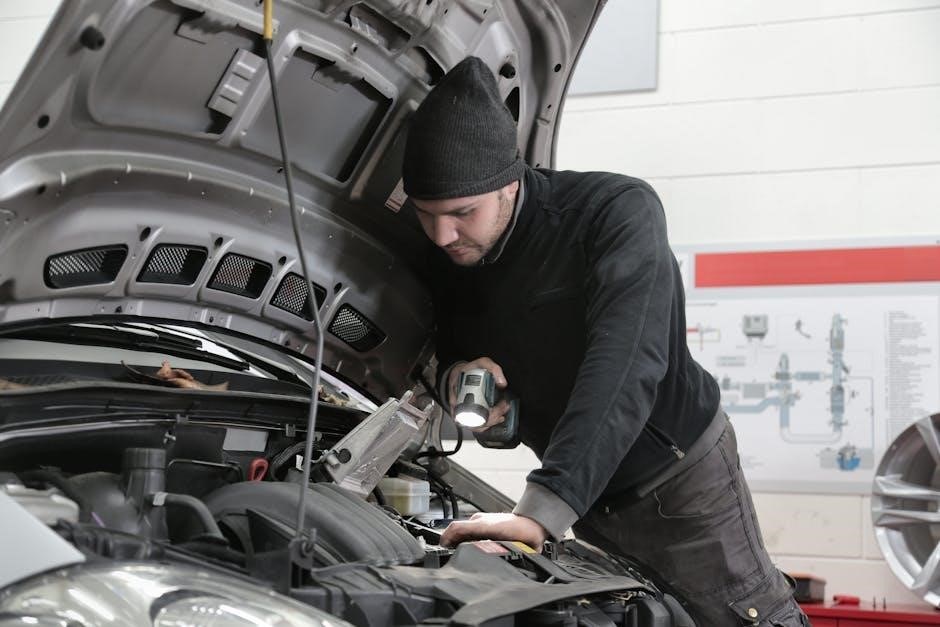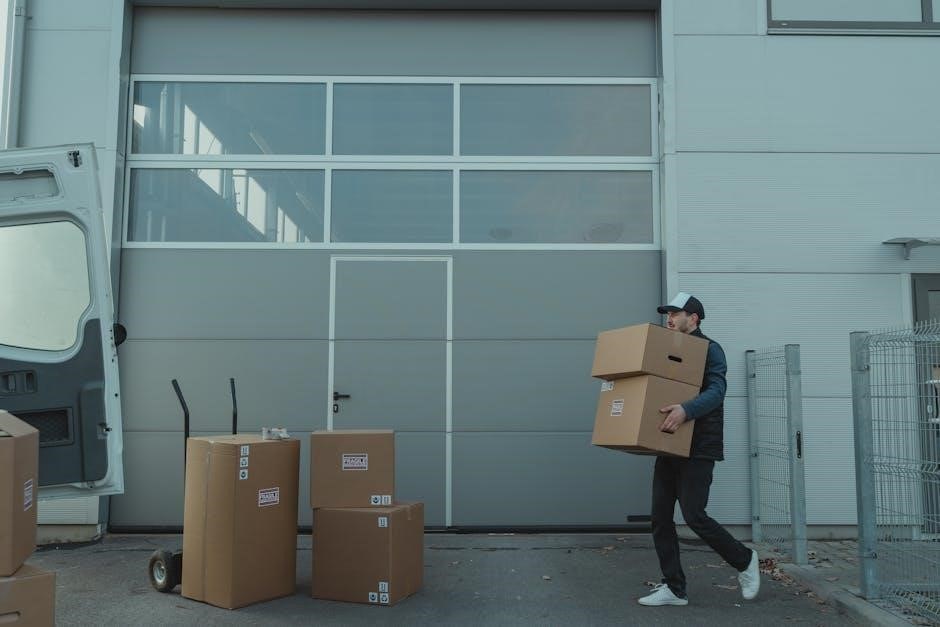
genie garage door opener troubleshooting guide
Having a Genie garage door opener enhances home convenience and security. However‚ like any technology‚ problems may arise. Understanding troubleshooting saves time and money‚ ensuring smooth operation. This guide explores common problems‚ effective troubleshooting steps‚ and maintenance tips for optimal performance. Regular maintenance is crucial.
Common Issues with Genie Garage Door Openers
Before diving into troubleshooting‚ let’s identify common issues with Genie garage door openers. One frequent problem is the door refusing to open or close‚ often stemming from a lack of power supply. Remote control malfunctions are also common‚ usually due to dead batteries or the need for reprogramming. Safety sensors‚ designed to prevent the door from closing on obstructions‚ can be triggered by even small items.
Noisy operation often indicates that moving parts require lubrication or that components are loose. Intermittent functionality can be traced to damaged wiring or a faulty wall switch. It’s essential to consult your Genie garage door opener’s user manual for model-specific troubleshooting tips. Resetting the opener can sometimes resolve issues‚ and modern models may benefit from firmware updates.
By recognizing these common problems‚ you can quickly narrow down the potential causes and begin the troubleshooting process efficiently. Remember to prioritize safety and consult a professional if you encounter complex issues or are uncomfortable performing repairs yourself. Regular maintenance can prevent many of these issues from occurring in the first place.
Checking the Power Supply
When your Genie garage door opener malfunctions‚ a primary step is verifying the power supply. First‚ ensure the opener is properly plugged into a functioning outlet. Test the outlet with another device‚ like a lamp‚ to confirm it’s providing power. If the outlet works‚ inspect the opener’s power cord for any visible damage‚ such as cuts or fraying.
Next‚ check your home’s circuit breaker. A tripped breaker can cut power to the garage. Reset the breaker if necessary. If the opener still doesn’t work‚ examine the wiring connections to the opener. Loose or damaged wires can disrupt the power supply. If you’re comfortable‚ carefully tighten any loose connections.
If all these steps check out and the opener remains unresponsive‚ the issue might be within the opener itself‚ requiring professional attention. Remember‚ safety first! If you’re not experienced with electrical work‚ consult a qualified technician to avoid potential hazards. A stable power supply is crucial for proper opener function.
Inspecting the Motor and Gear Assembly
If your Genie garage door opener clicks but doesn’t move‚ the motor and gear assembly could be the problem. Start by disconnecting the opener from the power source to ensure safety. Then‚ carefully examine the motor for any signs of damage‚ such as burnt wires or a damaged casing.
Next‚ inspect the gear assembly. This is often a plastic gear that can wear down or break over time; If the gear is stripped or damaged‚ it will need to be replaced. You can often find replacement gears online or at a local hardware store.
While you’re inspecting the gear assembly‚ also check for any obstructions or debris that might be preventing the motor from turning. Clean away any dirt or grime that you find. Once you’ve replaced the gear or cleared any obstructions‚ reassemble the opener and test it to see if it’s working properly. If the motor still doesn’t turn‚ it may need to be replaced.
Examining the Door for Obstructions
If your Genie garage door opener is not working‚ a simple yet often overlooked cause is an obstruction in the door’s path. Before diving into more complex troubleshooting‚ carefully examine the entire area surrounding the garage door. Look for anything that might be blocking the door’s movement‚ such as tools‚ toys‚ snow‚ or debris. Even small items can trigger the safety sensors and prevent the door from closing or opening properly.
Check the tracks on both sides of the door for any obstructions or damage. Make sure the rollers are moving smoothly within the tracks. If you find any debris‚ clean it out and lubricate the tracks with a garage door lubricant.
Also‚ inspect the springs and cables for any signs of damage or wear. If you notice anything unusual‚ it’s best to call a professional garage door technician to avoid injury. Once you’ve cleared any obstructions and inspected the door’s components‚ test the opener to see if it’s working properly.
Testing the Safety Sensors (Safe-T-Beams)
Genie garage door openers incorporate safety sensors‚ often called Safe-T-Beams‚ to prevent the door from closing if an obstruction is detected. These sensors are typically located near the floor on either side of the garage door opening. If your garage door opener isn’t working correctly‚ testing these sensors is a crucial troubleshooting step.
First‚ ensure that the sensors are properly aligned. Each sensor should be pointing directly at the other. Check for any obstructions blocking the path between the sensors‚ such as dirt‚ debris‚ or cobwebs. Clean the lenses of the sensors with a soft cloth.
Next‚ inspect the wiring connections to the sensors and the opener. Look for any loose or damaged wires. If you find any‚ tighten or replace them as needed. The sensors usually have indicator lights. One sensor should have a steady green light‚ and the other should have a steady amber light. If either light is blinking or off‚ it indicates a problem.
Troubleshooting Remote Control Problems
Remote control issues are a common frustration with Genie garage door openers. If your remote isn’t working‚ several factors could be at play. Start by checking the batteries. A dead or weak battery is often the culprit. Replace the batteries with new ones and test the remote again.
If new batteries don’t solve the problem‚ ensure you’re within the remote’s operating range. Obstructions or excessive distance can interfere with the signal. Try moving closer to the garage door opener and testing the remote again.
Next‚ verify that the garage door opener’s antenna is intact and properly positioned. The antenna receives the signal from the remote. If it’s damaged or misaligned‚ it can affect the remote’s performance. Straighten the antenna and make sure it’s free from any obstructions.
Sometimes‚ the remote may need to be reprogrammed to the garage door opener. Refer to your opener’s manual for instructions on how to reprogram the remote. This process usually involves pressing a “learn” button on the opener and then pressing a button on the remote.
Reprogramming the Remote
If your Genie garage door opener remote isn’t working‚ reprogramming it might be the solution. Reprogramming essentially re-establishes the connection between the remote and the opener unit. First‚ locate the “learn” or “program” button on your garage door opener motor unit. This button is usually located on the back or side of the unit.
Once you’ve found the button‚ press and release it. A small LED light near the button should start blinking or remain lit‚ indicating that the opener is in programming mode. Now‚ quickly grab your remote and press the button you want to use to open the garage door. Hold the button down for a few seconds.
The garage door opener should respond by either clicking‚ flashing its lights‚ or the door might move slightly. This indicates that the remote has been successfully programmed. If the door doesn’t respond‚ repeat the process. You might need to try pressing the remote button multiple times.
After the opener responds‚ test the remote by pressing the button again to open and close the garage door. If it works‚ you’ve successfully reprogrammed your remote. If not‚ consult your Genie garage door opener manual for specific instructions or contact a professional for assistance.
Understanding Blinking Light Codes (Model 7055)
If you own a Genie Model 7055 garage door opener‚ the blinking light codes can be invaluable for troubleshooting. These codes are a diagnostic tool that the opener uses to communicate potential problems. The number of blinks and the color of the light (if applicable) indicate specific issues.

For instance‚ a solid light usually signifies normal operation or that the power is applied. A blinking red light often indicates a problem with the safety sensors‚ such as misalignment or obstruction. Check that the sensors are clean and properly aligned‚ with no obstructions blocking the beam.
Different numbers of blinks can point to various issues‚ such as a faulty motor‚ limit switch problems‚ or issues with the wiring. Consult your Genie Model 7055 owner’s manual for a detailed list of blinking light codes and their corresponding meanings.
When troubleshooting‚ count the number of blinks carefully and compare it to the manual. This will help you pinpoint the exact problem and take the necessary steps to resolve it. If you’re unable to decipher the code or fix the issue yourself‚ it’s best to contact a qualified garage door technician for assistance. Understanding these codes can save time and effort in diagnosing opener issues.
Addressing a Clicking Sound Without Movement

If your Genie garage door opener makes a clicking sound but the door doesn’t move‚ it indicates a problem preventing the motor from engaging. This issue can stem from several potential causes‚ requiring a systematic approach to diagnose and fix. First‚ check the trolley release mechanism‚ ensuring it’s fully engaged. The trolley connects the opener to the door.
A common cause is a faulty start capacitor. The capacitor provides the initial surge of power needed to start the motor. If it’s weak or damaged‚ the motor may only click. Inspect the capacitor for any signs of swelling or leakage‚ replacing it if necessary.
Another possibility is a problem with the motor itself. Over time‚ the motor can wear out or develop internal faults. Listen closely to the motor. If the clicking is accompanied by a humming sound‚ it could indicate a seized motor. In this case‚ you might need to replace the entire garage door opener unit.
Also‚ examine the gear assembly inside the opener. Worn or broken gears can prevent the motor from transferring power to the door. Open the opener housing and inspect the gears for damage‚ replacing them if needed. By thoroughly checking these components‚ you can identify the reason for the clicking sound and restore your garage door opener’s functionality.
Adjusting the Limits of the Door Opener
If your Genie garage door doesn’t fully open or close‚ or if it reverses direction unexpectedly‚ adjusting the limits of the door opener is essential. The limits determine how far the door travels during opening and closing cycles‚ ensuring proper operation and preventing damage to the door or opener. Begin by locating the limit adjustment screws or buttons on the opener unit. These are typically labeled “Up” and “Down” or with symbols indicating direction.
To adjust the “Up” limit‚ use a screwdriver or press the corresponding button to increase or decrease the travel distance. Open the door to its desired fully open position‚ then fine-tune the “Up” limit until the door stops at that point consistently. Similarly‚ adjust the “Down” limit to control the closing position. Close the door and observe where it stops. If it doesn’t seal properly or reverses before touching the ground‚ adjust the “Down” limit until it closes fully and securely.
After each adjustment‚ test the door by opening and closing it several times to ensure it operates smoothly and stops at the correct positions. Make small adjustments and retest until you achieve the desired results. Refer to your Genie garage door opener manual for specific instructions and diagrams related to your model. Proper limit adjustments are crucial for reliable and safe garage door operation‚ preventing potential issues caused by incorrect travel settings.
Advanced Troubleshooting Techniques (Model 1035)
When dealing with a Genie Model 1035 garage door opener‚ certain issues may require advanced troubleshooting. These techniques go beyond basic checks and involve a deeper understanding of the opener’s components and functions. One common advanced issue is encoder failure‚ which can prevent the motor from accurately tracking door position. Testing the encoder involves using a multimeter to check the voltage and resistance readings‚ comparing them to the values specified in the service manual.
Another advanced technique is resetting the Model 1035 to its factory settings. This can resolve issues caused by corrupted programming or incorrect configurations. The reset procedure typically involves pressing and holding specific buttons on the opener unit for a set period‚ as outlined in the manual.
If the motor runs but the door doesn’t move‚ the gear assembly may be damaged or worn. Inspecting the gears requires disassembling the opener unit and visually examining the gears for cracks‚ stripped teeth‚ or excessive wear. Replacing the gear assembly involves removing the old gears‚ lubricating the new ones‚ and reassembling the unit.
Before attempting any advanced troubleshooting‚ ensure you have the necessary tools‚ technical knowledge‚ and safety precautions. If you’re uncomfortable performing these procedures‚ it’s best to consult a qualified garage door technician;
Preventative Maintenance Tips
Preventative maintenance is crucial for extending the life of your Genie garage door opener and preventing costly repairs. Regular maintenance keeps your garage door running smoothly and safely. One of the most important steps is lubricating moving parts. Use a silicone-based lubricant on the rollers‚ hinges‚ and tracks to reduce friction and noise. Avoid using oil-based lubricants‚ as they can attract dirt and grime.
Inspect the garage door springs regularly for signs of wear or damage. If you notice any cracks‚ gaps‚ or excessive rust‚ it’s time to replace the springs. Spring replacement can be dangerous‚ so it’s best to hire a professional for this task.
Check the safety sensors (Safe-T-Beams) to ensure they are properly aligned and free from obstructions. Clean the sensor lenses with a soft cloth to remove dust and debris. Misaligned or dirty sensors can prevent the door from closing properly.
Tighten any loose bolts or screws on the opener unit‚ tracks‚ and door. Loose hardware can cause vibrations and noise‚ and can eventually lead to more serious problems.

Finally‚ test the garage door’s balance by disconnecting the opener and manually lifting the door halfway. If the door stays in place‚ it’s properly balanced. If it drifts up or down‚ the springs may need adjustment.
When to Contact a Professional
While many Genie garage door opener issues can be resolved with basic troubleshooting‚ certain situations require the expertise of a professional technician. If you’re uncomfortable working with electrical components or dealing with heavy machinery‚ it’s always best to err on the side of caution and call a professional.
One clear sign that you need professional help is if you suspect a problem with the garage door springs. Springs are under high tension and can cause serious injury if mishandled. Replacing or adjusting springs should only be done by a qualified technician.

Similarly‚ if you encounter issues with the opener’s motor or wiring‚ it’s best to consult a professional. Electrical repairs can be dangerous‚ and incorrect wiring can damage the opener or create a fire hazard.
If your garage door is severely damaged or off its tracks‚ do not attempt to repair it yourself. A professional technician has the tools and experience to safely and effectively repair or replace the door.
Finally‚ if you’ve tried troubleshooting the problem yourself and are still unable to resolve it‚ it’s time to call a professional. A qualified technician can diagnose the issue and provide the necessary repairs to get your garage door opener back in working order.